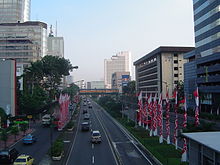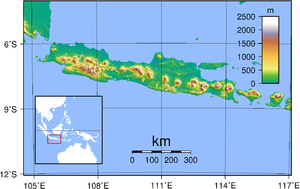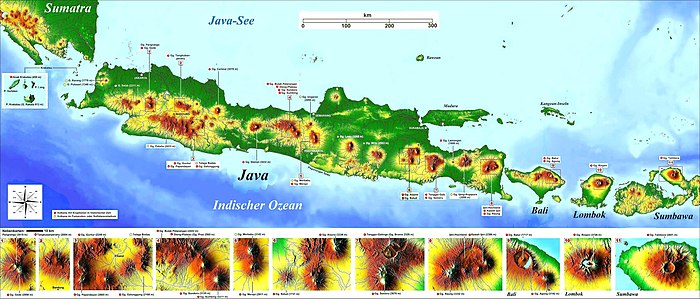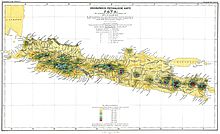Java (island)
| Java | |
|---|---|
| Bromo volcano in the middle left . In the background on the right the highest mountain in Java, the Semeru volcano . In front right the batok | |
| Waters | Indian Ocean , Java Sea , Bali Sea |
| Archipelago | Great Sunda Islands |
| Geographical location | 8 ° S , 111 ° E |
| length | 1 062 km |
| width | 199 km |
| surface | 126,700 km² |
| Highest elevation |
Semeru 3676 m |
| Residents | 141,300,000 1115 inhabitants / km² |
| main place | Jakarta |
Java , Indonesian Jawa (according to the old spelling Djawa ; pronunciation: [ dʒawa ], in German mostly [ ˈjaːva ]) is one of the four Great Sunda Islands of the Republic of Indonesia, along with the other main islands of Sumatra , Borneo ( Kalimantan ) and Sulawesi .
The Indonesian capital Jakarta is also located on Java .
geography
Java is located in the tropical belt between about 6 ° south / 105 ° east and about 9 ° south / 115 ° east south of Borneo and east of Sumatra in the Indian Ocean . The island has an area of 126,650 square kilometers - with smaller offshore islands such as Madura it is 132,107 square kilometers.
Java has about 141 million inhabitants (as of 2015), more than any other island on earth. With over 1100 inhabitants per square kilometer, the population density is one of the highest in the world. On Java is the capital of the island republic of Indonesia, Jakarta, with (2019) 10.5 million inhabitants. Jakarta continues to expand in area and grows together with the neighboring cities of Bogor , Depok , Tangerang and Bekasi , for which the term " Jabodetabek ", composed of the initial syllables of the names of the five cities, has become common.
The weather is shaped by the monsoons , which come from different directions. The island is extremely fertile. In the west there are still smaller areas of jungle, while to the east it becomes gradually drier. Free areas are largely cultivated, with numerous arable products being obtained from coffee to tobacco and maize . Rice cultivation is dominant, however, with large fields and rice terraces .
There are several river systems that arise from the volcanoes, some of which are over 3000 meters high. At around 600 kilometers, the Solo is the longest river. Other larger rivers are the Serayu and Progo .
In addition to the various manifestations of nature that can be observed ( jungle , savannah , mangrove swamps , a number of volcanoes and crater lakes , some of which are still active ), numerous temple complexes on Java testify to an eventful cultural history before the colonial era. The most important are the Buddhist temple of Borobudur and the Hindu temple of Prambanan .
Offshore islands
In addition to Madura in the northeast, there are other islands off Java. Bawean , the Karimunjawa Islands and Kepulauan Seribu are to the north.
In the Sunda Strait to the west are Panaitan , Sangiang and Krakatau , a volcanic island. The neighboring Legundi , Sebuku and Sebesi are closer to Sumatra.
Flora and fauna
The Java tiger (Panthera tigris sondaica) lived on the island until the 1980s . The endangered Java rhinoceros (Rhinoceros sondaicus) can still be found in the Ujung Kulon National Park in the southwest of the island.
Administrative structure
Administratively, Java is divided into the provinces of Banten , Jawa Barat (West Java), Jawa Tengah (Central Java), Jawa Timur (East Java) and the autonomous principality of Yogyakarta . The city of Jakarta is directly subordinate to the central government.
Cities

There are numerous large cities on the densely populated island:
- Jakarta with about 11 million inhabitants (capital of Indonesia)
- Surabaya with about 2.8 million inhabitants
- Bandung with about 2.3 million inhabitants
- Semarang with about 1.5 million inhabitants
- Depok with about 1.3 million inhabitants
- Bogor with about 950,000 inhabitants
- Malang with about 820,000 inhabitants
- Surakarta with about 500,000 inhabitants
- Yogyakarta with about 389,000 inhabitants
geology
Java is located, together with the larger northwestern neighboring island Sumatra and the smaller islands to the east, on the Sunda Trench (also Sunda Channel). The Sunda Trench, in turn, represents the subduction zone north of the Australian Plate . During the last Ice Age, Java was connected to the mainland and part of the Sundaland .
Java, almost entirely of volcanic origin itself, is part of the Pacific Ring of Fire , the volcanic belt that surrounds the entire Pacific Ocean . There are 38 partly extinct, partly still active volcanoes on the island; in all of Indonesia the number of active volcanoes is around 130. The most famous volcanoes include Bromo (2329 meters) and Merapi (approx. 2985 meters), which is considered to be one of the most dangerous volcanoes in the world. To the south of the Tengger Mountains with the Bromo rises the highest mountain in Java, the 3676 meter high active volcano Semeru .
In addition to volcanism, earthquakes are also frequent due to the geological conditions . The last severe earthquake was that of Yogyakarta on May 27, 2006 with a magnitude of 6.3 on the moment-magnitude scale . The hypocenter was, according to the USGS about 20 kilometers southeast of the city of Yogyakarta at a depth of approximately twelve kilometers. According to the UN on June 5, 2006, the main quake, followed by more than 1,000 aftershocks with a magnitude of up to 5.2, claimed the lives of almost 5,800 people, up to 57,800 were injured, and more than 130,000 houses were destroyed or seriously damaged and up to 650,000 people were left homeless. The city of Bantul was hardest hit , where around 2,400 people died and four fifths of the buildings were destroyed. The Prambanan temple complex , which was initially closed to visitors, was also badly damaged . The nearby Merapi volcano, which had already shown increased activity in the weeks before, emitted a cloud of gases and ash around 3.5 kilometers high shortly after the first quake. In the days after the quake, its activity increased at least twice as much.
Another danger comes from seaquakes, which can cause tsunamis . The seaquake off Java on July 17, 2006 with a magnitude of 7.7 on the Richter scale, the epicenter of which was around 400 kilometers from the coast, caused a tidal wave that, according to eyewitness reports, reached a height of up to four meters. More than 660 people fell victim to collapsing buildings, around 300 are missing. In addition, around 30,000 people became homeless. The town of Pangandaran , which is especially popular with locals as a vacation spot , was particularly hard hit .
In May 2006, the regional company Lapindo drilled a hole about three kilometers deep in Kecamatan Porong to find suspected oil. However, the oil deposit turned out to be an underground water deposit, which is now noticeable as a mud volcano, a large mud fountain at 140 degrees Celsius. The Sidoarjo mud volcano has already flooded many villages and towns in eastern Java. Attempts to channel the putrid silt into rivers have so far failed. Geologists suspect that it could take years for the water to drain sufficiently for the volcano to dry up. Whether that will happen at all is also controversial. The latest attempt is to seal the drilled point of the water deposit with a heavy liquid called Micromax .
history
Prehistoric time
The fact that the island of Java was already settled in prehistoric times is proven by the discovery of the " Java man ", a subspecies of Homo erectus , which was found by the Dutch anthropologist Eugene Dubois in 1891 near Trinil on the Solo River in the Jawa Timur province .
Pre-colonial period
In the 1st millennium AD Buddhism and Hinduism gained a foothold on the island and merged with the beliefs of the original peasant culture. Several empires were formed, the most powerful of which were Pajajaran and Majapahit . The latter was conquered by the Sultan of Ternate in 1304 , but in 1359 it came back into the possession of the monarch Hayam Wuruk , who subsequently ruled the entire island as emperor for a long time. Java benefited economically from its location on important sea trade routes to China . Culturally, however, takeovers from India remained decisive. A parallel development took place on the neighboring island of Sumatra .
At the beginning of the 15th century, Muslim traders came to the island from Gujarat, India , and a conversion to Islam began.
Colonial times
Although the Portuguese had established their first trade connections as early as 1579, they were soon ousted by the Dutch who first landed in 1594 . On June 1, 1619, the Dutch conquered Jakarta , which they made the center of their colonial empire in Asia under the name of Batavia . In Java itself they initially limited themselves to rule over the city. In 1629 Sultan Agum von Mataram besieged the Dutch colony, but remained unsuccessful. The Javanese nobility also felt threatened by Agum and resorted to the help of weapons from the technically superior Dutch. In return, they had to cede land to the Dutch East India Company (VOC). As a result, the VOC took control of the entire island in the 17th century. Java was at the junction of the Asian sea routes and thus allowed the Dutch to have extensive control of trade outside of India, which was dominated by England.
Simultaneously with the establishment of colonial rule, Islam also spread to Java. It gained popularity mainly because it was seen by many locals as a counterbalance to the culture of Europeans. On the other hand, the Dutch made hardly any attempts at Christian proselytizing.
The Dutch used the Chinese as traders and tax collectors, making them unpopular with the local population. Tensions also grew between the Dutch and the Chinese because the colonial rulers increasingly viewed uncontrolled immigration from China as a danger. In 1740 thousands of Chinese were killed in a pogrom in Batavia. Both the local Muslim population and the Dutch colonial troops took part in the murders. A year later, the colonial administration officially released all Chinese on Java for killing, which led to further pogroms.
At the beginning of the 19th century, the Dutch state took direct control of the colony after the VOC had been declared bankrupt on December 31, 1799, and, in cooperation with the Javanese nobility, increased the economic exploitation of the rural population. After the British-Dutch War for Java in late summer 1811, the island fell to the British, but was returned to the Netherlands after the Napoleonic Wars .
From 1825 to 1830 there was a popular uprising against the Dutch because of a new tax that the locals had to pay on the rice harvest. Over 200,000 Javanese and 8,000 Europeans fell victim to the fighting in the so-called Java War .
In 1830 the so-called cultuurstelsel was introduced. Instead of paying rent, the farmers should now make a fifth of their land available to grow crops specified by the government on this land. Part of this system was that they used their labor 66 days a year for the benefit of the government. In practice, the burdens for the farmers often went far beyond the official requirements. The goods were shipped to Europe and sold there for a profit. The Dutch writer and former colonial official Eduard Douwes Dekker criticized this system in his book Max Havelaar , published in 1860 under the pseudonym Multatuli .
During the Second World War , the island was occupied by Japanese troops in March 1942 and remained occupied until the surrender of Japan . An estimated 2.4 million residents died during this time, among other things due to a catastrophic famine in 1944/45.
Time until today
Java and the capital Jakarta have been the center of the Republic of Indonesia since independence was proclaimed .
population
language
In addition to the official language Bahasa Indonesia , the Javanese language is spoken in the central and eastern parts of Java , and the Madurese language in the northeast . In the western part of Java, the Sundanese language is predominant.
religion
In Java, Muslims make up the majority of the population. Java was Islamized in the 15th and 16th centuries , so that today around 91 percent of the Javanese and 97 percent of the Sundanese are Muslim.
The Netherlands first sent Christian missionaries to Java around 1815 . As a result, many Chinese converted to Christianity , as well as a few Javanese who had not yet accepted Islam.
In the south of central Java there are some Christian communities, the majority of which are members of the Chinese minority .
Fifty-eight percent of the Muslim Javanese describe themselves as Abangan , which means that they do not regard Sharia as directly applicable law. The rest are Santri , who have a more orthodox interpretation of Islam.
economy
Rice-oriented agriculture was originally widespread in Java. During the Dutch colonial rule, the plantation economy (sugar cane, rubber, tea, coffee and quinine) was introduced.
Today Java is the most developed island in Indonesia, with several industrial and business centers and an extensive road system and railway network.
literature
- Robert Hatley, Jim Schiller (Eds.): Other Javas: Away from the Kraton. Monash University Press, Clayton 1984, ISBN 978-0-86746-334-7
- Norbert Hofmann: The Islamic festival calendar in Java and Sumatra . (Dissertation) Bock and Herchen, Bad Honnef 1978, ISBN 3-88347-000-7
- Mochtar Lubis : Dawn in Jakarta . (Roman) Unionsverlag, Zurich 1997, ISBN 3-293-20098-2
- Thomas Stamford Raffles : The History of Java. Black, Parbury, and Allen, London 1817 ( Online at Internet Archive )
- MC Ricklefs: A History of Modern Indonesia Since c. 1200. 4th edition, Stanford University Press, Palo Alto (CA) 2008
Web links
- Search for Java Island in the German Digital Library
- Klaus Oepen: Community- oriented disaster risk management and risk perception of the population at the Merapi volcano 2011 (PDF file; 416 kB)
- Central Java
Individual evidence
- ^ Indonesia (Urban City Population): Provinces & Cities - Statistics & Maps on City Population . Citypopulation.de. January 7, 2019. Accessed March 30, 2019.
- ↑ Pierre van der Eng: Food Supply in Java during War and Decolonization, 1940–1950 , Australian National University, 2008, p. 38.






